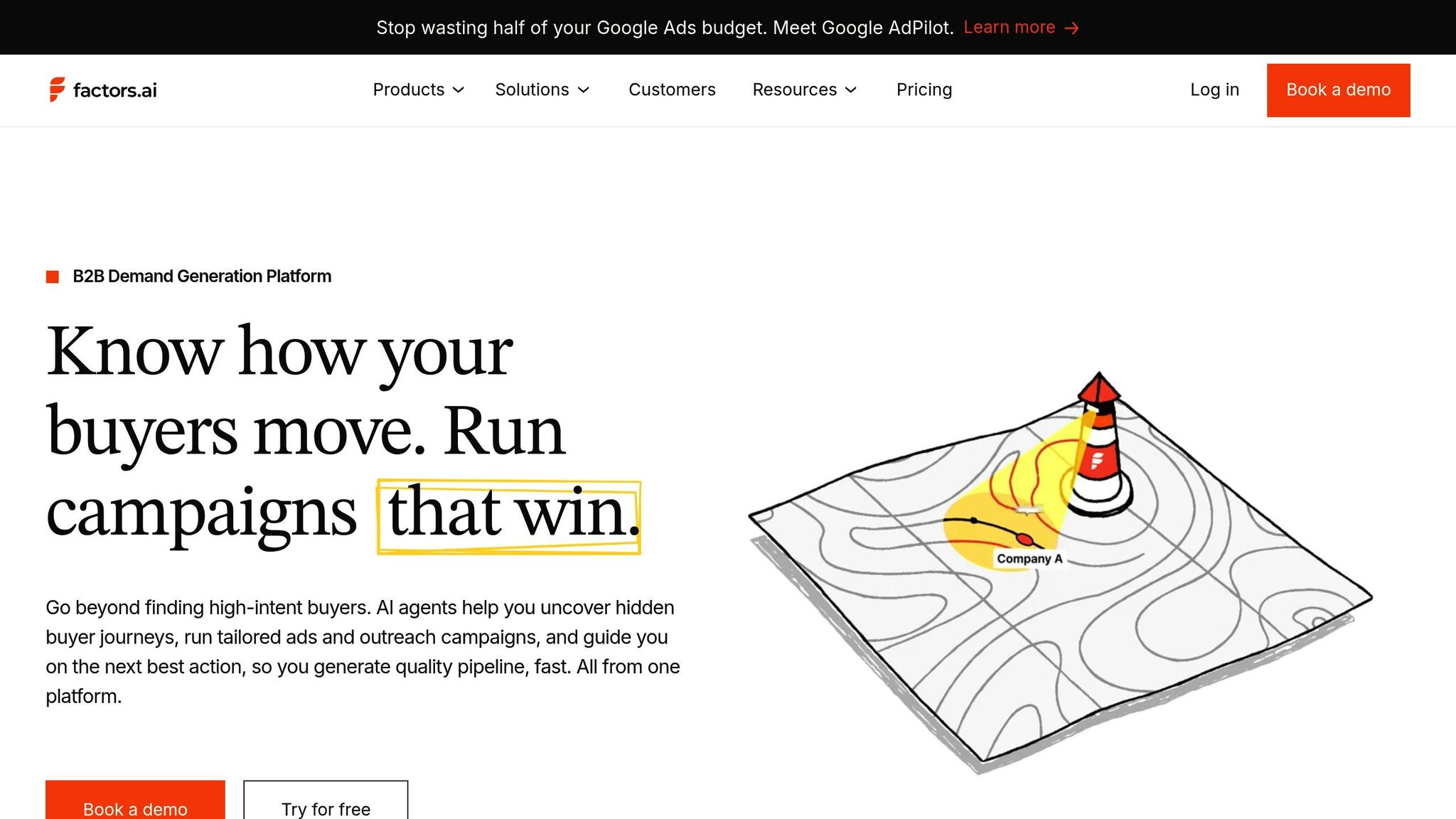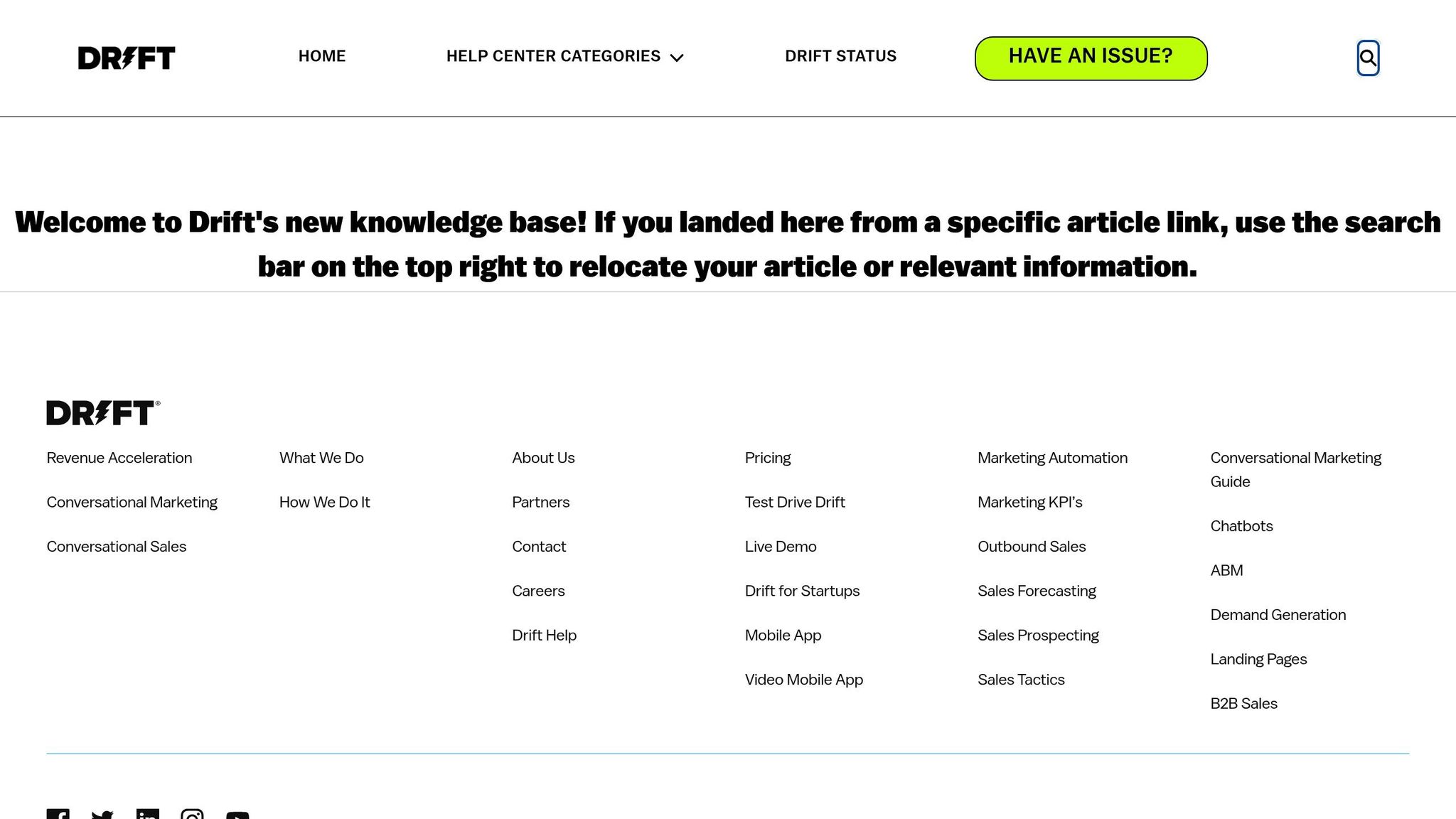
Sales teams are increasingly turning to AI tools to improve lead targeting, automate repetitive tasks, and boost efficiency. These tools help identify high-potential prospects, personalize outreach, and streamline workflows. Here’s a quick overview of the top options:
- SalesMind AI: Focuses on LinkedIn automation with features like lead scoring, CRM integration, and automated follow-ups.
- Persana: Offers signal-based selling but lacks detailed public information on features.
- Copilot AI: Specializes in LinkedIn prospecting with reply prediction and dynamic lead scoring.
- Factors.ai: Combines intent signals from multiple sources for precise targeting and segmentation.
- Drift: Uses conversational AI to engage website visitors and qualify leads in real time.
- LeadFuze: Automates lead sourcing, validation, and enrichment for targeted outreach.
- Apollo.io: Provides data enrichment, outreach automation, and multi-touch campaign workflows.
These tools vary in pricing and features, making it important to match your choice to your business needs. For example, Drift is ideal for real-time website engagement, while SalesMind AI and Copilot AI excel in LinkedIn-based strategies. Apollo.io offers a cost-effective entry point for small teams, starting at $49/user/month.
Quick Comparison:
| Tool | Key Features | Best For | Starting Price |
|---|---|---|---|
| SalesMind AI | LinkedIn automation, lead scoring, CRM sync | B2B LinkedIn outreach | Custom pricing |
| Persana | Signal-based selling, custom AI models | Large-scale prospecting | Custom pricing |
| Copilot AI | LinkedIn AI, reply prediction, segmentation | LinkedIn lead generation | ~$500/month |
| Factors.ai | Intent signals, visitor ID, predictive scoring | Data-driven marketing teams | Custom pricing |
| Drift | Conversational AI, chatbots, real-time routing | Website engagement | ~$2,500/month |
| LeadFuze | Lead sourcing, data enrichment, validation | SMBs, recruiters, sales teams | $147/month |
| Apollo.io | Outreach automation, email sequencing | Sales teams, SMBs, enterprises | $49/user/month |
These platforms are reshaping sales strategies by saving time, improving lead quality, and enabling more targeted outreach. Choose the one that aligns with your goals and integrates with your existing tools.
16 Insane AI Lead Generation Systems for 2025 (with PROOF!)
1. SalesMind AI

SalesMind AI simplifies LinkedIn outreach and B2B lead generation by automating key processes like personalized messaging, lead qualification, and follow-ups. Designed specifically for LinkedIn, it helps sales teams engage directly with decision-makers in the B2B space. The platform has received strong user ratings, such as 4.4 on Trustpilot, 4.7 on G2, and a perfect 5.0 in the Chrome Store [2].
AI-Powered Lead Scoring
SalesMind AI’s lead scoring feature takes the guesswork out of prioritizing leads. By analyzing data like engagement history and behavioral patterns, it assigns a priority score to each prospect. This allows sales teams to focus on leads with the highest potential, rather than wasting time on less promising ones. The scoring system is tailored to predefined filters, ensuring relevance.
Svit Babarovic from MountainDrop shared his thoughts:
"The lead scoring system is particularly impressive, providing clear insights into lead quality." [2]
The results speak for themselves: one B2B SaaS company achieved a 40% boost in qualified leads and cut prospecting time by 25% [1]. And that’s just the start - SalesMind AI’s integration tools make the whole process even smoother.
Integration Capabilities
Seamless integration is a standout feature of SalesMind AI. It connects with LinkedIn to manage outreach directly on the platform and syncs effortlessly with popular CRM systems. This ensures lead data, activity tracking, and workflows are automatically updated, saving time and reducing manual effort. On top of that, the platform automates follow-ups, so no potential lead slips through the cracks.
Automation for Outreach and Follow-ups
SalesMind AI handles personalized messaging and follow-ups with ease, using engagement data to guide its timing and content. Responses are managed through an AI-powered inbox, making it easier for users to focus on closing deals rather than sifting through messages. Jure, CEO of Jure Design, highlighted this feature:
"I like that it shows you a score on what the lead suitability with your filters is." [2]
This level of automation allows users to spend their time where it matters most - building relationships and closing sales.
Real-time Lead Tracking and Segmentation
With real-time tracking, SalesMind AI monitors how leads interact with outreach efforts and segments them based on engagement, demographics, and behavior. This enables sales teams to quickly identify high-intent prospects and adjust their strategies for better conversion rates. By delivering these actionable insights, SalesMind AI ensures that sales efforts are both targeted and effective.
2. Persana
Information about Persana is quite limited compared to SalesMind AI. There’s little confirmed data regarding its AI-driven lead targeting capabilities. Key details about features like lead scoring, CRM integration, and real-time tracking are also unavailable from trustworthy sources. For the most accurate and up-to-date insights, it’s best to refer directly to Persana's official resources.
3. Copilot AI

Copilot AI is a LinkedIn-focused prospecting platform that uses artificial intelligence to simplify and enhance outreach efforts. Built specifically for LinkedIn, it automates prospecting activities while ensuring compliance with the platform's policies.
AI-powered Lead Scoring
One of Copilot AI's standout features is its Reply Prediction AI, which evaluates multiple data points to score leads based on their likelihood to respond. By analyzing LinkedIn activity, profile details, and engagement patterns, the platform pinpoints high-intent prospects. It considers factors like recent job changes, content engagement, and communication styles to predict which leads are most likely to interact with your outreach.
This scoring system allows sales teams to focus on leads with the best conversion potential, boosting campaign ROI and minimizing wasted time. Additionally, Copilot AI integrates these insights into a streamlined workflow for more efficient prospecting.
Integration Capabilities
Copilot AI works seamlessly with LinkedIn Sales Navigator, enabling users to automate prospecting directly within the LinkedIn environment. This integration enhances LinkedIn's search and filtering tools by adding AI-driven automation, making prospecting faster and more effective.
It also connects with popular CRM systems, syncing lead data with your existing sales processes. This centralized setup ensures all prospecting activities are tracked in one place, eliminating the need to juggle multiple platforms and reducing the risk of losing critical prospect information. These integrations create a cohesive and automated approach to outreach.
Automation for Outreach and Follow-ups
The platform takes care of daily connection requests and follow-up messages while staying within LinkedIn's usage limits to ensure compliance. This safeguards user accounts from being flagged or restricted by LinkedIn's algorithms.
Using prioritized leads, Copilot AI personalizes messages and schedules follow-ups at the right time. For example, if a prospect views your profile or interacts with your content, the platform can automatically initiate a tailored follow-up sequence, keeping the engagement timely and relevant.
Real-time Lead Tracking and Segmentation
Copilot AI continuously refreshes lead scores based on new engagement data, ensuring your prioritization reflects the latest prospect behavior. This dynamic approach keeps your sales strategy aligned with changing engagement patterns throughout the sales cycle.
The platform also segments leads by response likelihood and communication preferences, updating these segments as engagement evolves. This allows sales teams to fine-tune their outreach strategies - whether a prospect prefers direct communication, needs additional nurturing, or shows strong purchase intent.
Additionally, Copilot AI offers communication style insights, analyzing LinkedIn profiles to uncover personality traits and preferred interaction methods. This feature helps sales teams craft messages that feel more personal and resonate with each lead’s unique style, increasing the likelihood of meaningful responses.
Sales teams on G2 have highlighted Copilot AI’s ability to predict prospect responses and automate LinkedIn outreach effectively, making it a trusted tool for LinkedIn-driven lead generation [3].
4. Factors.ai

Factors.ai is an account intelligence platform designed to bring together intent signals from various touchpoints, providing a clear picture of buyer behavior. While it shares similarities with other AI tools, its defining feature lies in its unified account intelligence, which takes targeting precision to another level.
AI-Powered Lead Scoring
Factors.ai uses intent signals from multiple sources - websites, product reviews, ad interactions, and CRM activities - to score leads based on their actual engagement levels. By employing reverse IP lookup, it maps website interactions and evaluates leads beyond simple demographic data, focusing on meaningful engagement.
A standout feature is its ability to generate dynamic account lists. These lists are built using both firmographic and behavioral filters, and the AI keeps them updated as fresh intent signals come in. This ensures your targeting remains sharp and relevant. Additionally, the platform provides actionable insights through its AI agents, offering suggestions for the next best steps. These recommendations are tailored to each prospect’s buyer stage and specific interests, making outreach efforts more effective.
Integration Capabilities
Factors.ai integrates seamlessly with major platforms like CRM tools, LinkedIn, G2, and Slack, while also supporting custom integrations via webhooks. By consolidating intent signals from these sources, it creates a centralized hub for prospect intelligence.
Its LinkedIn integration is particularly noteworthy. Users can run highly targeted LinkedIn ad campaigns based on buyer stages and interests identified by the platform. Detailed conversion data is then sent back to LinkedIn, creating a feedback loop that continuously improves ad performance.
"We have far more visibility of how our LinkedIn efforts influence different stages of the sales funnel." - Daniel Michan, Senior Head of Digital Marketing, Akeyless [4]
This integration enables dynamic segmentation, ensuring campaigns stay aligned with real-time buyer behavior.
Real-Time Lead Tracking and Segmentation
One of Factors.ai’s strengths is its real-time intent monitoring. The platform tracks prospect behavior across all connected channels, allowing sales teams to create highly specific segments based on both firmographic and behavioral data. These segments are automatically updated as new data comes in, keeping your targeting strategies in sync with current prospect activity.
The platform’s unified dashboard provides a clear view of pipeline drivers and buyer journeys. This makes segmentation and outreach more precise, helping sales teams act on the most relevant opportunities at the right time. Real-time segmentation also plays a key role in optimizing advertising efforts, ensuring better campaign efficiency without the need for increased budgets.
"Factors is core to our stack. We use it for ads, full-funnel engagement, and giving sales clear visibility into who's engaging and why." - Shane Poyar, Growth Marketing and Ops, Descope [4]
With its ability to track and segment leads in real time, Factors.ai has become an essential tool for improving campaign performance while staying cost-effective.
sbb-itb-817c6a5
5. Drift

Drift leverages conversational AI to engage website visitors instantly, replacing traditional static forms that often create unnecessary friction. Instead of waiting for visitors to fill out forms, Drift's chatbots spark natural conversations, qualifying prospects on the spot and directing high-intent leads straight to sales teams.
This approach is particularly effective at capturing visitors who might otherwise leave without taking action. Drift’s AI-driven chatbots ask targeted questions based on visitor behavior, helping businesses increase qualified leads by 30% and reduce sales cycle time by 20% [5]. Let’s break down how Drift’s AI scoring, integrations, and automation features turn website interactions into sales-ready opportunities.
AI-Powered Lead Scoring
Drift’s chatbots analyze responses and behavior during conversations to automatically score leads, prioritizing those with the highest potential [5][6]. This scoring system ensures that sales teams focus their efforts on the most valuable prospects, cutting down on manual work and boosting conversion rates.
The system evaluates multiple factors, such as the questions prospects ask, their engagement level, and specific challenges they mention. By doing so, Drift provides a clear picture of each lead’s readiness to buy - without relying on lengthy forms or multiple follow-ups.
Integration Capabilities
Drift integrates with leading CRM platforms like Salesforce and HubSpot, streamlining the lead management process. These integrations enable automatic syncing of lead data, real-time routing, and up-to-date contact records. This ensures that both sales and marketing teams have accurate, real-time information for personalized outreach, eliminating the need for manual data entry [5][6].
Automation for Outreach and Follow-ups
Drift takes automation to the next level by handling outreach, answering visitor queries, and even scheduling meetings autonomously. For follow-ups, it triggers personalized email sequences or sends notifications to sales reps based on a lead’s activity and engagement. This automation significantly reduces response times, ensuring no high-potential lead slips through the cracks [5][6].
Drift also uses behavior-based messaging to send targeted communications based on user actions and browsing history. This tailored approach increases relevance, making it easier to convert leads into customers [6].
Real-Time Lead Tracking and Segmentation
Drift continuously updates lead data through real-time tracking of visitor interactions and behavior. It segments leads based on criteria like engagement levels, company details, and conversation outcomes. This segmentation allows sales teams to deliver customized messaging and focus on the most promising leads, improving conversion rates and campaign ROI [5][6].
With its chatbots available 24/7, Drift gathers insights around the clock, building detailed visitor profiles that refine targeting strategies over time. This ensures businesses can adapt their approach to meet the evolving needs of their audience.
Drift’s advanced features start at approximately $2,500 per month, reflecting its robust capabilities in driving inbound lead engagement.
6. LeadFuze

LeadFuze simplifies lead sourcing and prospecting by using AI to deliver pre-qualified leads tailored to specific criteria like job title, location, or industry. The platform continuously updates prospect lists, enriching contact details with firmographic and technographic data. This makes personalized outreach faster and more efficient.
AI-Powered Lead Scoring
One standout feature of LeadFuze is its AI-driven lead scoring. The platform evaluates a variety of data points - such as job roles, company size, and engagement signals - to rank and prioritize leads most likely to convert [6]. By automating this process, sales teams can concentrate on high-value prospects, boosting conversion rates while avoiding time wasted on less promising leads.
Integration Capabilities
LeadFuze works seamlessly with major CRM platforms, enabling automatic transfer of enriched lead data into existing sales workflows [6]. While it doesn’t directly automate LinkedIn outreach, it does source LinkedIn profile data and integrates with engagement tools. This ensures sales teams can manage leads effectively without the hassle of manual data entry, keeping records accurate and up-to-date.
Automation for Outreach and Follow-ups
The platform takes automation a step further by streamlining outreach and follow-up processes. LeadFuze can initiate outreach sequences based on predefined criteria [6], route leads to the right sales reps, and send behavior-based messages for targeted communication. This reduces manual tasks and ensures timely, personalized follow-ups, keeping prospects engaged.
Real-Time Lead Tracking and Segmentation
LeadFuze also provides real-time tracking of leads, continuously updating prospect lists and enabling precise segmentation [6]. Users can filter leads by attributes like industry, location, or company size, making targeted campaigns easier to execute. Additionally, its built-in data validation ensures emails and phone numbers are accurate, minimizing bounce rates and improving message deliverability.
LeadFuze offers subscription plans with tiered pricing based on the number of leads and included features. Subscriptions are available on a monthly or annual basis, billed in US dollars.
7. Apollo.io

Apollo.io takes AI-powered lead targeting to the next level, making sales outreach smoother and more efficient. By automating outreach and follow-ups, Apollo.io helps sales teams save time and focus on meaningful interactions. Its built-in email sequencing and multi-touch campaign workflows handle complex outreach tasks, speeding up the sales cycle and improving engagement with prospects.
For inbound leads, Apollo.io simplifies the process by automating nurture and follow-up sequences. These sequences adapt dynamically based on a prospect's responses. The platform also includes AI-driven call summaries and automatically creates tasks, ensuring no follow-up falls through the cracks. This consistency helps teams replicate successful strategies with ease.
"Every rep is more productive with Apollo. We booked 75% more meetings while cutting manual work in half." - Andrew Froning, BDR Leader [7]
Feature and Pricing Comparison
When choosing the right platform for your business, it's crucial to weigh both features and costs to find the best fit.
Pricing ranges widely across platforms. Apollo.io offers a free tier with paid plans starting at $49/user/month. LeadFuze begins at $147/month, while Copilot AI is priced around $500/month. At the higher end, Drift costs approximately $2,500/month. Meanwhile, SalesMind AI, Persana, and Factors.ai provide custom, usage-based pricing, offering flexibility for businesses with evolving needs.
Here’s a breakdown of key features, ideal use cases, and starting prices for each platform:
| Tool | Key Strengths | Best For | Starting Price |
|---|---|---|---|
| SalesMind AI | LinkedIn automation, AI lead scoring, unified inbox | B2B LinkedIn outreach | Custom pricing |
| Persana | Signal-based selling, custom AI models, enrichment | Large-scale B2B prospecting | Custom pricing |
| Copilot AI | LinkedIn AI, reply prediction, sentiment analysis | LinkedIn lead generation | ~$500/month |
| Factors.ai | Predictive scoring, visitor ID, cross-channel intent | Data-driven marketing teams | Custom pricing |
| Drift | Conversational AI, real-time routing, chatbots | Real-time website engagement | ~$2,500/month |
| LeadFuze | Automated sourcing, validation, enrichment | SMBs, recruiters, sales teams | $147/month |
| Apollo.io | Data enrichment, outreach automation, integrations | Sales teams, SMBs, enterprises | $49/user/month |
Each tool brings unique strengths to the table. SalesMind AI is tailored for LinkedIn outreach, offering advanced lead scoring and a unified inbox to streamline communication. Apollo.io is known for its extensive data enrichment and seamless integration with various tools, making it a favorite among sales teams. For real-time customer interaction, Drift leads the pack with conversational AI and chatbot capabilities. If automated lead sourcing and validation are priorities, LeadFuze is a strong contender.
Many platforms provide free trials or demo versions, allowing you to explore their functionality before committing. For instance, Apollo.io’s free tier gives smaller teams access to basic features, making it a cost-effective starting point for businesses new to AI-driven tools.
Integration capabilities are another critical factor. Tools like Apollo.io and SalesMind AI offer robust CRM integrations, while Factors.ai focuses on cross-channel data integration. Ensuring compatibility with your current tech stack can streamline workflows and boost efficiency, saving both time and resources.
While higher-priced solutions may seem daunting, they often deliver strong returns. Copilot AI is praised for saving time and improving campaign management, while LeadFuze stands out for its reliable data and automation features. Apollo.io frequently earns high marks for its all-in-one functionality and value.
Support levels also differ. Enterprise-focused tools often include dedicated support and custom training, while lower-cost options tend to rely on self-service resources. Consider your team’s technical expertise and the time available for onboarding when making your decision.
Conclusion
AI tools have reshaped how businesses approach lead targeting and segmentation. By moving from manual prospecting to intelligent automation, sales teams can now focus their energy on building relationships and closing deals, rather than getting bogged down by repetitive tasks.
When choosing AI tools, prioritize those that handle time-consuming tasks like messaging, follow-ups, and lead tracking. Advanced lead scoring systems are also key - they help pinpoint the most promising prospects, ensuring your efforts are directed toward leads with the highest conversion potential. The ultimate aim? To scale your prospecting efforts without the need for additional staff, all while ensuring smooth integration with your existing tools and workflows.
Speaking of integration, this is a crucial factor when selecting AI-driven platforms. Tools that connect seamlessly with platforms you already use - like LinkedIn - create centralized workflows and make lead management far more efficient. This streamlined approach enables teams to expand their outreach without sacrificing control or organization.
As your business grows, it's important to choose tools that can grow with you. Whether you're a small business just starting out or a large enterprise aiming to speed up deal cycles, unified platforms often offer more value and efficiency compared to using multiple, disconnected solutions.
To measure success, track metrics like conversion rates, lead quality, and the time saved on manual tasks. Many platforms provide flexible pricing options, from credit-based models to tailored enterprise solutions, making it easier to find one that fits your budget and delivers measurable results.
Ultimately, align your choice of tools with your sales goals. Look for platforms that are user-friendly, enhance productivity, and support your team's growth as you scale your lead generation efforts.
FAQs
How can AI tools improve lead targeting and boost sales performance?
AI tools make lead targeting sharper and help sales teams perform better by automating tasks like crafting personalized messages, qualifying leads, and managing follow-ups. This means businesses can connect with potential customers more effectively and on a much larger scale.
With capabilities such as advanced lead scoring and smooth integration with other platforms, these tools simplify the sales process. They allow teams to prioritize top leads and speed up deal closures.
What should businesses look for when selecting an AI tool for lead targeting?
When selecting an AI tool for lead targeting, it's important to focus on features that directly support your sales objectives. Prioritize tools that provide advanced lead segmentation, allowing you to categorize prospects effectively. Features like personalized messaging and automation can save time and make outreach efforts more efficient.
Another key consideration is integration capabilities. Tools that work seamlessly with platforms like LinkedIn or your CRM system can simplify workflows and reduce manual tasks. Look for options that offer AI-powered insights, such as lead scoring and analytics, to help you identify and prioritize high-value prospects.
Lastly, think about scalability and usability. The tool should be easy for your team to adopt and capable of adapting as your business grows. Make sure it aligns with the unique needs of your industry and target audience to maximize its effectiveness.
How do AI tools with integration features enhance sales processes?
AI tools that effortlessly connect with platforms like LinkedIn, CRM systems, and email tools can simplify sales workflows in a big way. These integrations make data sharing smoother, improve lead tracking, and streamline communication, saving time and effort.
Take LinkedIn integrations, for instance. They can automate tasks like outreach, handle follow-ups, and even analyze engagement metrics. This frees up sales teams to concentrate on closing deals rather than juggling repetitive, manual work. By bringing processes and insights together in one place, AI tools with integration capabilities not only boost productivity but also help businesses strengthen connections with potential customers.


.avif)


